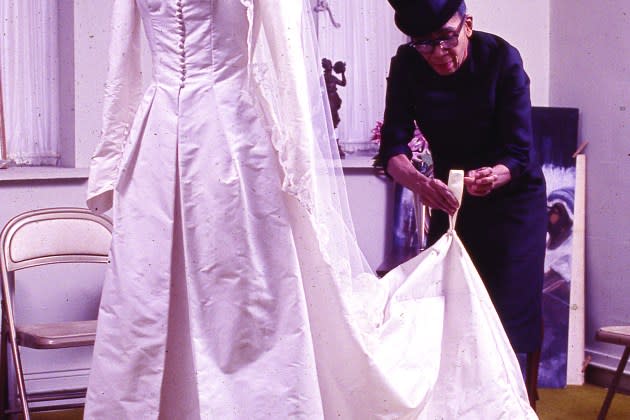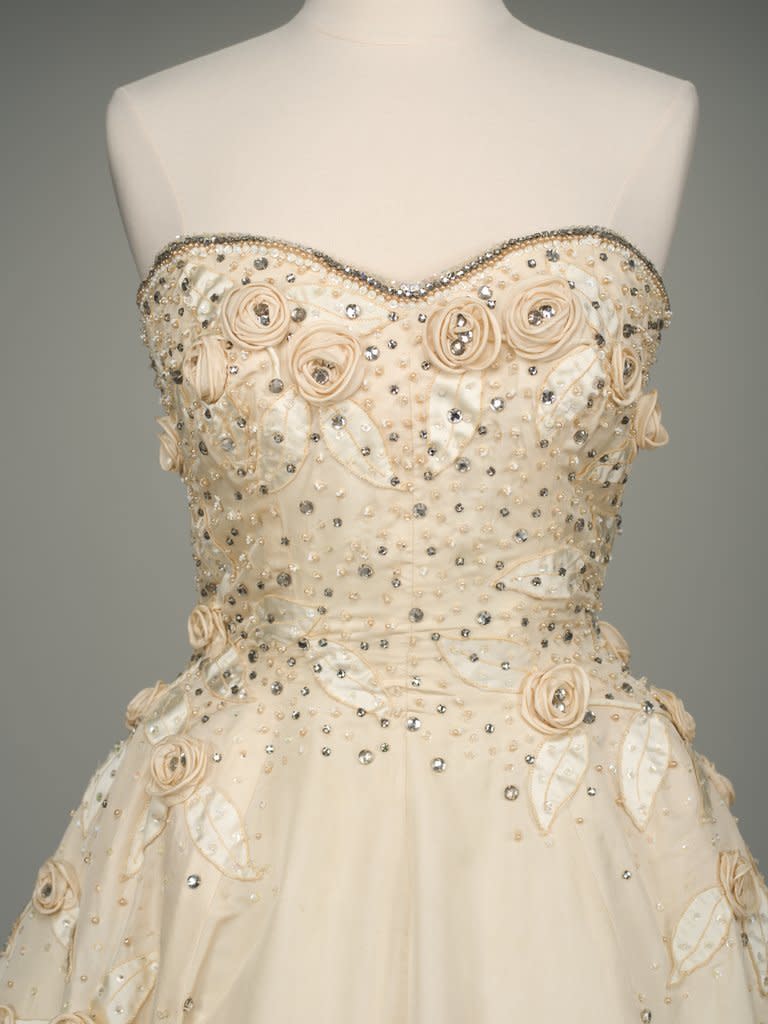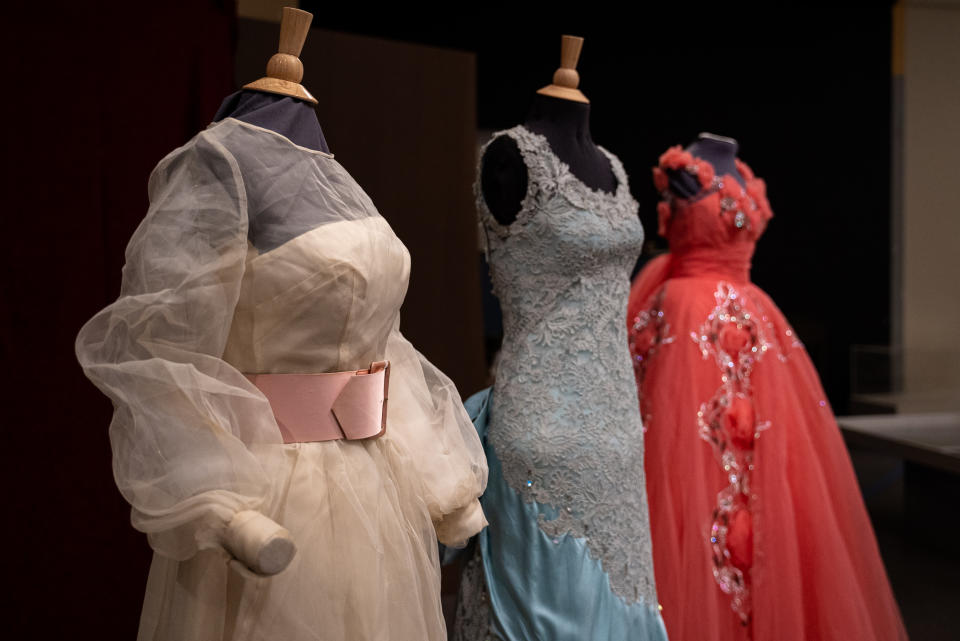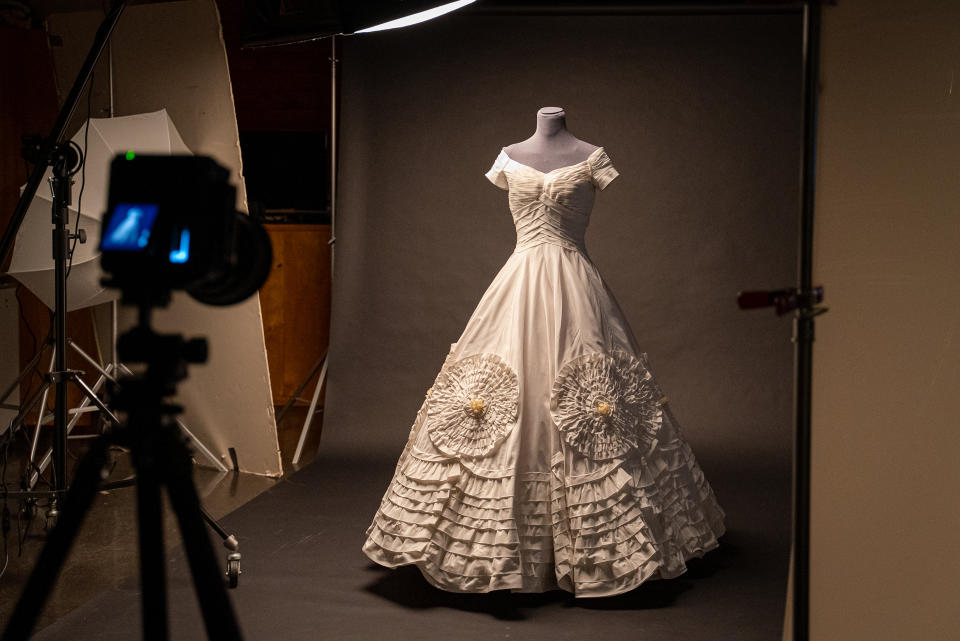This Biggest-ever Ann Lowe Exhibit Is Set to Shine a Light on the Long Under-credited American Designer
- Oops!Something went wrong.Please try again later.
- Oops!Something went wrong.Please try again later.
- Oops!Something went wrong.Please try again later.

Many who know the name Ann Lowe entered her story when she designed Jacqueline Bouvier’s wedding dress for her marriage to John F. Kennedy and wasn’t credited for it. But beyond that, there’s still too little known about the designer, who would spend 60 years crafting couture-quality gowns for the highest of American society.
Now a new exhibit, “Ann Lowe: American Couturier” — the largest ever of her work — opening Saturday at the Winterthur museum in Delaware, and the matching book being released alongside it, are unraveling more of the story that was nearly never sewn into the fabric of fashion’s history.
More from WWD
Baby pink tulle is the first feast for the eyes; a ballgown Lowe designed in 1961 that, as Elizabeth Way, who wrote the book and is guest curating the exhibition, describes, “really shows off her mastery of color.”
“Her style was very feminine, it was very traditional. She worked in a 19th century dressmaking practice so she built dresses from the inside out — everything from the interior structure, the bras and bodices she built in, working its way out in layers. She had a lot of handmade embellishments, whether it’s beading, appliqué, creating three-dimensional fabric flowers, everything was done with a lot of handwork and a lot of attention to detail.”
To see her pieces in person — 40 of which will be on display spanning designs she created from 1928 through 1968 — is “breathtaking,” according to Way.
“When you see each dress in detail, you get this immediate impression of how elegant and how feminine and fashionable these silhouettes were,” she continues. “But when you look close, you start to see all these little details pop out at you, so it’s really a multilayered experience. And to be in the gallery and surrounded by all of them at the same time is actually very special.”

Before Way met Lowe as a figure to uncover (she’d write her master’s thesis on Lowe and Elizabeth Keckley, whose stories as under-acknowledged Black dressmakers, she found, share similarities) Margaret Powell was unearthing her story. It was Powell, the scholar credited in the book’s preface for her early and in-depth work to bring Lowe to light, who had the idea for the Winterthur exhibit. When she died in 2019, Winterthur invited Way to curate it. It was also Powell who wanted the world to understand that Lowe’s story can’t be limited by race alone.
In the early pages of the book, Powell writes about an interview Lowe did on “The Mike Douglas Show” in the ‘60s when she said the driving force behind her work was “to prove that a Negro can become a major dress designer.” For Powell, “the predominant theory behind Lowe’s exclusion from the story of popular American fashion is simply that the American public was not ready for her argument.”
While that would have been true, Powell says “this almost single-minded focus on race” kept history from really analyzing Lowe as a designer and considering her body of work. Still, despite the hardships she faced, race-related and otherwise, Lowe could never be mistaken in claiming her rank as a major dress designer.
“If we really look at haute couture output, it’s really on that level,” Way says. “She was a very important American designer who contributed a lot to the American fashion culture. It wasn’t all ready-to-wear coming from Seventh Avenue; she was making couture in the same ways they were making it in France. So we have that level of talent and skill here in the United States and she helped build what we think about as American fashion.”
The exhibit, like the book, catalogues Lowe’s journey and the dresses that decorate it.

From her birth in Alabama circa 1898 (her self-reported birth date never matched local census data), the daughter and granddaughter of dressmakers, to taking up that baton as early as age 5, when she started sewing scraps into the fabric flowers that would ultimately become a staple of her designs, the book follows Lowe to Tampa, where she heads at the request of society woman Josephine Edwards Lee to outfit her and her daughters. There she designs under her married name, and Annie Cone becomes the label of note for wedding gowns, bridesmaid’s dresses, debutante balls and the local Gasparilla festival. The Lee family, whose wealth stemmed from the citrus business, would ultimately support Lowe’s studies at a dressmaking school in Manhattan and later, in setting herself up for a long career there.
She arrived in New York City just before the Great Depression with money she had accumulated and a mindset to make it, whatever the odds. She dropped her married name and became Ann Lowe. In the city, Lowe would design for Neiman Marcus, Saks Fifth Avenue and for her own namesake business at different points in time.
She built up her client base which, before long, consisted of the New York Social Register, meaning she kept busy crafting designs for these prominent families and their full calendars of events and appearances.
A sampling of all of these dresses appear in the exhibit.
“We look at groups of dresses,” Way says. “The first one we encounter is a bit of a historical timeline of what you’ll see in the exhibition. It charts her work from the 1920s through the 1960s and it really shows the changing silhouettes. She had a very, very long career, so this section is a little insight into her biography and talks about the span that she was designing over.”
From there, the exhibition looks at debutante gowns, fantasy gowns, a ’20s Gasparilla dress and wedding gowns, including a replica of Jacqueline Kennedy’s wedding dress (the original lives at the John F. Kennedy Presidential Library and Museum) painstakingly done by Katya Roelse, an instructor in the fashion and apparel program at the University of Delaware and a freelance technical designer. Way says Roelse attributed the experience to “walking in her footsteps and the very intricate work that she did.”

Lowe designing that dress — though it could have been the catalyst for an even more prominent and perhaps global career had she been credited — became the now-controversial moment that really brings her into the wider fashion conversation, years after the wedding.
In its own coverage in a 1953 article, WWD would describe the dress, saying: “The bride wore ivory silk taffeta with horizontal tucking on snug bodice and around the hem of the full skirt, which was further embellished with round medallions done in tucking,” also without crediting Lowe.
It wasn’t until 1961, when Ladies Home Journal published a piece on the new first lady, including a line about her wedding that read: “The bride’s gown and those of her bridesmaids were designed by a colored woman dressmaker, not the haute couture,” that people knew anything about who had designed Kennedy’s dress. And Lowe wasn’t happy at all.
“Ann Lowe did take exception to that,” Way says.
In the book, Way continues, “Lowe wrote to Kennedy expressing ‘how hurt I feel as a result of an article….I realize it was not intentional on your part but as you once asked me not to release any publicity without your approval, I assume that the article in question, and others, was passed by you….I have worked hard to achieve a certain position in life which has been considerably more difficult due to my race. At this late point in my career, any reference to the contrary hurts me more deeply than I can perhaps make you realize.’”
Lowe asked instead to be described as “a noted negro designer” not even requesting her name be included. Research shows Kennedy’s press secretary called Lowe to apologize, saying the words were the reporter’s and not the first lady’s, and that Kennedy wasn’t aware they were being written.
Lowe would have many high points and setbacks over the course of her contribution to fashion, but she remained hopelessly devoted to making dresses until glaucoma finally took her eyesight and prevented her from doing so. It’s a story more than worthy of fashion’s recognition.
But why now for the exhibit?
“Now is as good a time as any — it should have happened earlier but this is when we were able to put it all together. I think it’s a long time coming, but it’s always a good time to think about what new stories we can tell about fashion history or history in general. Ann Lowe has a fascinating story, she has a lot of really beautiful material culture and I think we are in a moment, more than ever, that people are interested in fashion exhibitions, interested in fashion history,” Way says. “In the wake of the resurgence of the Black Lives Matter movement in 2020, people are also interested in what’s been left out of history, especially in regard to Black artists and creatives of all kinds.”
Sections on Lowe’s construction techniques, how past clients kept and altered her work to match modern styling, as well as pieces from contemporary designers like B Michael, Tracy Reese and Amsale Aberra, who have drawn on the foundation Lowe laid, round out the exhibit, which runs through Jan. 7, 2024.
The 208-page companion book published by Rizzoli on Sept. 5, will help to solidify Lowe’s life and work in the fashion record.
While there are no plans at present for “Ann Lowe: American Couturier” to travel, Way says she hopes it kicks off a series of exhibits around and including Lowe’s work.
“For [this] exhibition I want people to walk in and really be awed by the beauty. That’s what she was really about, was just creating really beautiful dresses. And we see these dresses from the 1920s through the 1960s, so just to get lost in the beauty of her material culture,” she says. “But I also want other museums, other scholars to be more aware of her work, what they have in their collections and just incorporate it into their exhibitions. Whatever those themes might be. Her work can speak to a lot of different themes and I hope that she’s just more integrated into fashion history from now on. And I hope that the book serves as a really great resource to help other scholars, emerging scholars and existing curators do that.”
Best of WWD

